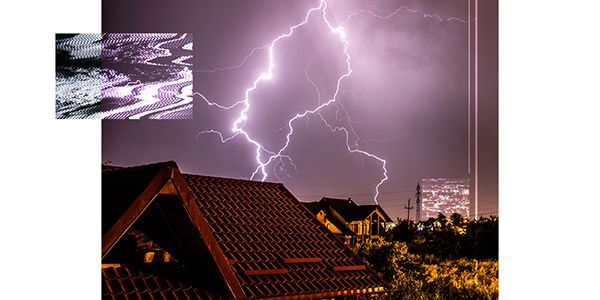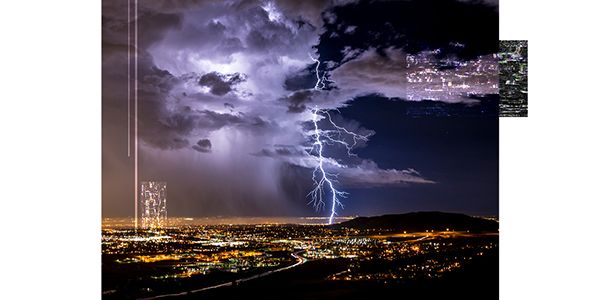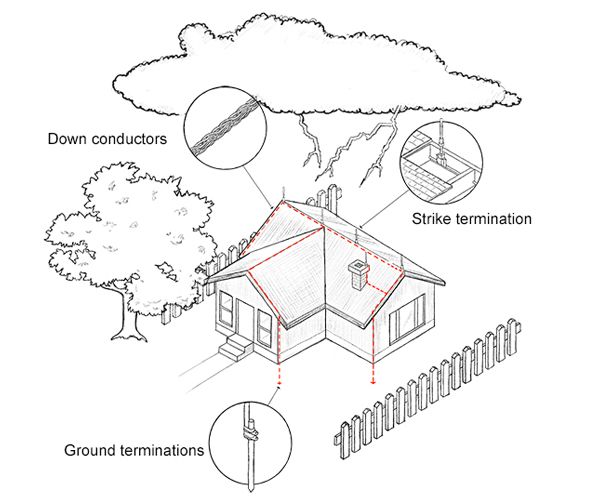One night last spring, Connie Anderson was jolted awake by an incredible clap of thunder that sounded like it was right over her Bentonville, Arkansas, home. It was “like a bomb had gone off in the house,” Anderson recalls.
She was frightened, but she smelled no smoke and no alarms went off, so she and her husband, Brad, went back to sleep. “We didn’t realize something was wrong until the next day,” she says.
When they woke, they noticed an error message on the oven clock — not the usual blinking triggered by a power outage. The home security system was chirping. And when Anderson went to leave for the gym, the garage door opener wasn’t working.
Slowly, they noticed more damage: televisions wouldn’t turn on; the internet router was off; the exterior lights and irrigation system didn’t work. It dawned on Anderson that what had woken her up was a lightning strike near her home. “Wherever it hit was very, very close,” she says. So close, in fact, that its electrical charge caused more than $5,000 in damage to the home’s appliances and electronics.
If you suspect a lightning strike, call 911
Home protection
Get personal service from a
Farmers® agent.
Most people think of lightning strikes as incredibly rare, but lightning strikes the contiguous United States approximately 25 million times per year according to the National Severe Storms Laboratory. In 2018, more than 77,000 homes experienced lightning damage, totaling more than $900 million in losses.
Lightning is the most under-recognized threat among weather hazards, in part because strikes can happen anywhere at any time, says Loehr.
Loehr, who lives in Richmond, Virginia, was born into a family that has been in the lightning protection system business since 1947. Throughout her career, including a stint as president of the United Lightning Protection Association, she has worked to raise awareness about the dangers of lightning after seeing the damage it can cause — the ferocious fires, fried electronics, exploded chimneys and worse.

How Lightning Damages Homes
Fire
If lightning hits a non-conductive material, like a roof, it can spark a fire; even without a direct hit, a nearby lightning strike can reach a home’s wiring through the ground or wires coming into the house, overload the electrical system and ignite a smoldering burn. Between 2014 and 2018, lightning caused an average of 3,800 home fires a year in the United States, according to the National Fire Protection Association (NFPA).

If lightning hits a non-conductive material, like a roof, it can spark a fire; even without a direct hit, a nearby lightning strike can reach a home’s wiring through the ground or wires coming into the house, overload the electrical system and ignite a smoldering burn. Between 2014 and 2018, lightning caused an average of 3,800 home fires a year in the United States, according to the National Fire Protection Association (NFPA).

This happened to Loehr 17 years ago, in a home she had purchased but not yet moved into. One morning a neighbor smelled an electrical fire, went into Loehr’s new house and found the electrical box smoldering. Loehr believes a nearby lightning strike traveled to the circuit breaker panel. “My house probably would have burned down if no one had come in,” she says.
Power surges
Home wiring typically carries 120 volts of electricity, but a lightning strike near a power line can send through millions of volts, ruining appliances and other electronics plugged into the system (just like Connie Anderson’s). As Americans bring more electronics into their homes, power surges are a big factor behind the 21 percent rise in the average insurance claim for lightning damage — from about $9,600 in 2016 to more than $11,600 in 2018.

Home wiring typically carries 120 volts of electricity, but a lightning strike near a power line can send through millions of volts, ruining appliances and other electronics plugged into the system (just like Connie Anderson’s). As Americans bring more electronics into their homes, power surges are a big factor behind the 21 percent rise in the average insurance claim for lightning damage — from about $9,600 in 2016 to more than $11,600 in 2018.

Shock waves
In a millisecond, lightning superheats the surrounding air to almost 50,000 degrees. The heated air expands in an explosive burst. When lightning is far away, the shock wave manifests as thunder, but it can hit homes or businesses with explosive force, Loehr says. Shock waves can crack foundations, split concrete and brick structures, break glass and destroy plaster walls.

In a millisecond, lightning superheats the surrounding air to almost 50,000 degrees. The heated air expands in an explosive burst. When lightning is far away, the shock wave manifests as thunder, but it can hit homes or businesses with explosive force, Loehr says. Shock waves can crack foundations, split concrete and brick structures, break glass and destroy plaster walls.


“Nobody thinks it will happen to them.”
A shock wave is what Christy Blair first noticed in August 2019 after lightning struck close to her home in suburban Roswell, Georgia. She was at home sick, dozing through an afternoon thunderstorm, when she heard “the biggest boom ever.” She ventured outside — and found a hole about six inches deep and two feet wide blasted out of her front lawn. Bark on eight trees in her front yard had popped off, and white burn marks spiraled up the trunks. “It was definitely a surprise when it struck — and it hit the ground — to see how much damage it caused,” Blair says. She didn’t realize then that her garage door opener, audio systems and other home electronics were also damaged.
Georgia, where she lives, is second only to Florida in the number of homes damaged by lightning each year. While she did worry about trees falling, flooding and other kinds of storm damage, it had never occurred to her to protect her home from lightning.
Will Priestley, who has been installing lightning protection systems around New England for 36 years, says most people don’t think about lightning — until they’ve seen what a lightning strike can do. “Like anything bad, nobody thinks it will happen to them,” he says.
Even people who understand the risks of lightning think of lightning protection systems as “witchcraft,” Priestley jokes. But, he adds, there’s no magic to the systems — just science.
It’s a lesson Loehr learned early. When she was in third grade, her father rigged up her doll house with a lightning protection system and, using a Tesla coil, simulated a lightning strike for Loehr’s class. When the jolt hit the house, the electricity traveled through special wires to light a bulb underneath the house — just the way a lightning protection system would channel electricity from a real lightning strike along a low-resistance path and deep into the ground, where it can’t do as much damage.

3 Ways to Reduce Damage When Lightning Strikes
LIGHTNING PROTECTION SYSTEM
Estimated Cost: $0.50 to $3 per square foot*
A lightning protection system is based on the scientific principle that electricity follows the path of least resistance. The system is built to give the electricity in a lightning strike a low-resistance pathway around a home’s pipes and wiring and into the ground, where it is dispersed with little or no damage to the structure. These systems are why skyscrapers like the Empire State Building — which is hit about 23 times per year — can escape damage. Although these systems can be highly effective, they’re rare. Loehr estimates only about 3 percent of American homes have one.
HERE'S HOW IT WORKS: A building’s roof is equipped with rods, or strike termination devices. The rods are all connected by wire, which connects to at least two main conductors — copper or aluminum cables (or steelwork, in some cases) that run toward the ground. Having at least two routes splits the force of the electricity to minimize the strain on the conductors. These main conductors run into a grounding electrode system to disperse electricity safely into the earth. The whole system is bonded, which means it’s designed to prevent lightning from jumping into other conductors in the home, like wires or pipes.

The LPI recommends that lightning protection systems be installed by a trained professional (organizations like the LPI and UL, a safety certification company, certify installers and inspect systems). The National Fire Protection Association provides a national standard for the installation of lightning protection systems. Costs vary widely because systems must be customized to the home*, depending on the region, shape of a home’s roof and materials used.
Once a system is in place, homeowners should conduct an annual visual inspection and have a professional complete a whole-system inspection every three years, Loehr says.
WHOLE-HOUSE SURGE PROTECTOR
Estimated Cost: $50 to $150, plus installation
A whole-house surge protector, also known as a surge suppressor or UPS device, works like the ones that people use to protect their computers. It’s just bigger and is hard-wired into the home’s main electrical panel, where power enters the home’s circuit. This device may offer some protection against power surges and distant lightning strikes by sensing a power surge and diffusing excess electricity into the ground. This may help reduce the damage to a home’s electrical system and the electronics, appliances and other devices plugged into it.
Whole-house surge protectors are designed to handle the average strike, but not bigger-than-average ones, and do not protect a home itself from a direct hit, says Loehr. Homeowners who opt for a whole-house surge protector may consider using smaller plug-in protectors as well, for extra protection (average cost: $10 to $40, depending on level of protection provided) for appliances, Priestley says.
As of 2020, whole-home surge protectors are required in new dwellings under the National Electrical Code. In existing homes, professional installation is recommended, Priestley says, and it should take a pro about two hours to install.
Unplugging appliances
Cost: Free
Unplugging major appliances can protect them from a surge caused when lightning strikes a nearby power line or by a lightning strike itself. Appliances should be unplugged when thunderstorms are forecast but before a storm gets close. “Do not do it during a storm,” Loehr says. Connie Anderson does this — but says it’s an imperfect system: The night her house was struck, no storms were forecast, so she hadn’t unplugged anything. Plus, she says, “You can’t run around and unhook everything,” especially hardwired electronics like her home security system, which was ruined.

When a chimney is blown to bits, seeing is motivating
After Blair’s yard was struck, she had to have her home security and stereo systems repaired and a few small appliances replaced. The eight trees that were hit in the front yard had to be cut down, which “changed the look of the house,” she says.
Blair and her husband also had a whole-home surge protector installed — “not something I would have thought to do before,” she says.
Priestley says that most of his business comes from people who have already experienced a strike: “The people who see chimneys blown to bits with bricks all over the yard… it’s hard to imagine until you experience it.”

Where lightning
strikes most
The top 10 states for the number
of homes damaged by lightning in
2018, according to data from the
Insurance Information Institute.
Florida: 7,108
Georgia: 5,539
California: 4,909
Texas: 4,559
Louisiana: 3,553
North Carolina: 3,119
Alabama: 2,942
New York: 2,938
Pennsylvania: 2,590
Illinois: 2,475
Written by
The information contained in this page is provided for general informational purposes only. The information is provided by Farmers® and while we endeavor to keep the information up to date and correct, we make no representations or warranties of any kind, express or implied, about the completeness, accuracy, reliability, suitability or availability with respect to this article or the information, products, services or related graphics, if any, contained in this article for any purpose. The information is not meant as professional or expert advice, and any reliance you place on such information is therefore strictly at your own risk.
Related articles



